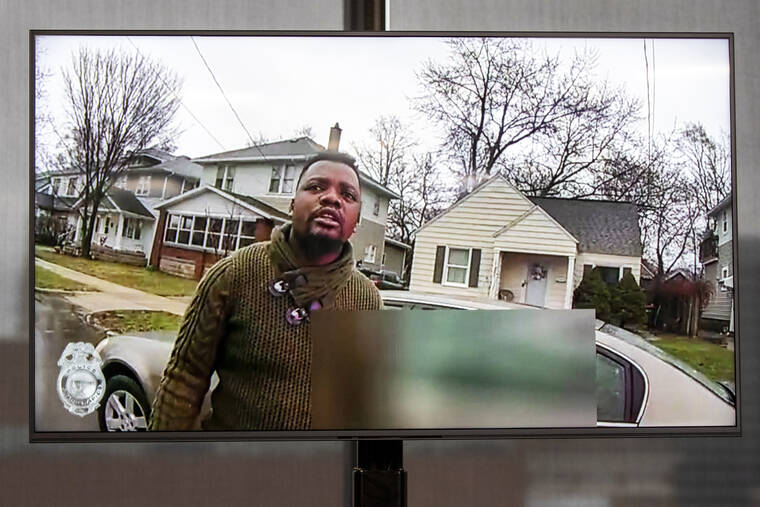Officer’s camera misses key moment of Patrick Lyoya’s death
Body camera footage of Patrick Lyoya’s fatal encounter with a Michigan police officer shows a close-up view of an intense struggle, but the video goes dark 42 seconds before the officer shoots the Black man in the head.
It’s the latest high-profile case in which body cameras — touted as tools to hold police accountable — have failed, leaving prosecutors and the public to rely on bystander video for a clearer picture of what happened.
ADVERTISING
One expert said vendors could make changes to avoid accidental camera deactivations, though it’s not clear that is what happened in Lyoya’s case, and some activists said an accident seems unlikely. Regardless, Lyoya’s family and their attorneys say it shows the importance of citizen video. The shooting was captured by Lyoya’s passenger, with a cellphone, and a doorbell camera across the street.
“Keep videoing the police because transparency is important for them and it’s sure important for us,” said Ben Crump, an attorney for Lyoya’s family.
The officer was on top of Lyoya, who was facedown on the ground, when he shot the 26-year-old Congolese refugee in the head April 4.
Body camera video released by police this week shows the initial stop, and the officer saying the car’s license plate wasn’t registered to the vehicle.
It shows Lyoya’s attempt to run away and a struggle as the officer repeatedly tells him to stop. At one point, Lyoya has his hand on the officer’s stun gun, and the officer yells at him to let go.
The video then goes black. Police dashcam captured some audio but no images of the shooting.
Official sources can have limitations for a variety of reasons, such as the limited view of the dashcam in the Grand Rapids incident, or the fixed viewpoint of a surveillance camera. In the recent Brooklyn subway attack, computer system problems kept authorities from either recording or viewing footage on security cameras in the station where the subway train stopped after Frank James allegedly opened fire.
Other cameras in the system worked, however, and provided critical evidence.
Grand Rapids Police Chief Eric Winstrom said officers have to hold a button on the camera for three seconds to turn it off. He said the button was hit many times during the struggle in this case, but at the point the screen went dark “that was the first moment that it was held down for more than three seconds. That’s what deactivated it.”
One body camera expert said it appeared to have been unintentional.
“That officer, he is in a full-on struggle with that citizen. And I’m sure turning the camera off would’ve been the least of his concerns,” said Michael White, a professor at the School of Criminology and Criminal Justice at Arizona State University and co-director of training and technical assistance for the U.S. Department of Justice Body-Worn Camera Policy and Implementation Program.
White couldn’t think of another case in which an officer’s camera was unintentionally turned off during a struggle.
But cameras are sometimes knocked off officers’ uniforms.
The Axon Body 3 camera used by Grand Rapids police has a large circular button on the front surrounded by a ridge, so the button is slightly recessed. Officers tap the button twice to record and hold it down for three seconds to turn it off.
Axon said it remains “committed to developing technology and training for public safety” but declined to comment further, citing the investigation.


